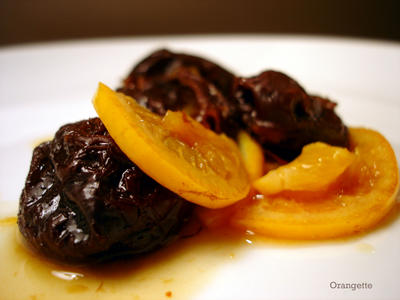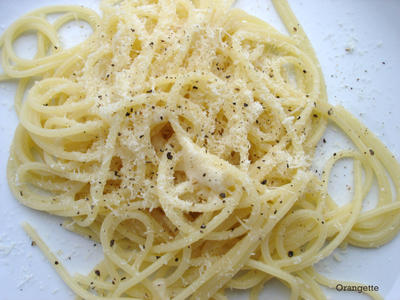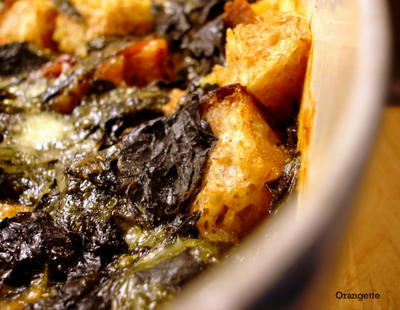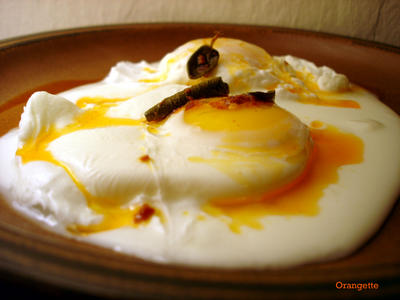Month: October 2005
The semantics of stewing
In the English language, there are only a handful of phrases that come with their own built-in laugh track, and sadly, “stewed prunes” is one of them. Witness the following exchange, tearfully recorded by yours truly during a phone conversation earlier this week:
Molly: I’m thinking of making stewed prunes.*
Brandon: [Giggle].
Molly: Why are you laughing? Have you ever eaten a stewed prune?
Brandon: [Giggle]. No, but it just sounds funny. I mean, steewwwed pruuune! [Giggle giggle].
It is a dark, dark day, dear reader, when you learn that the man you love—and whose genetic material you would like to help perpetuate, even—is a prune skeptic.
In his defense, Brandon claims that he dislikes all dried fruits, the unfortunate result of being forced to eat too much “hippie trail mix” as a child. Now, it’s bad enough that the delicious prune—or, to use its new, marketing-friendly name, the dried plum—has to work an unglamorous side-job as a laxative, but for it to be discriminated against on the basis of childhood trauma is simply unfair. And anyway, if we really get down to semantics, stewed prunes aren’t dried fruits anymore. They’re soft, swollen, gushy pockets of heady, sweet-tart juice.

I like to think of prunes as plums that have been
bettered by hardship, plums made wiser by old age and wizening,
and I consider myself lucky to have been schooled in the simple
art of stewing from an early age.
My father, a fan of cook-while-you-sleep breakfasts, used to load up a
late-night saucepan with prunes, water, and thin slices of
orange and lemon, bring it to a boil, cover it, turn off the
heat, and let it sit until morning. The
Food Safety and Inspection Service
would likely look askance at such a method, but it did make ours
a relatively happy, mainly healthy, pro-prune household.
Today I prefer a method that’s a little more conventional but every bit as effortless: a short, gentle simmer over low heat, with no stirring, poking, or prodding required. You’ll know that your prunes are properly stewed when an almost liqueur-like aroma wafts out of the saucepan. The fruit should slump on the spoon, and its skin should yield to the tooth with a gentle, dainty pop. Its silky, juicy pulp should be both warming and wintery, a deep, round, heartening flavor that’s delicate but deathly serious.
If I have my way, even the most hard-boiled of prune skeptics will be stewed into submission.
*Thank you, David Lebovitz, for believing in prunes.
Stewed Prunes with Citrus and Cinnamon
Adapted from
Tomato Blessings and Radish Teachings
When I wanted to recreate the flavor of my father’s overnight stewed prunes, I turned to a little feel-good cookbook-cum-self-help-book by Edward Espe Brown, Zen monk and author of several well-known vegetarian cookbooks. Brown treats his prunes as simply as possible, and rightly so. To my palate, prunes are the loveliest of dried fruits: they lack the shrill, high-pitched sweetness of raisins and the sticky, cloying sugar of dates, and their low, dark flavor has more depth than, say, a dried apricot. These stewed prunes get additional nuance, too, from thin slivers of citrus fruits, which go into the pot bitter peel and all. They’re delicious warm, with thick, Greek-style plain yogurt, or atop a bowl of oatmeal, dabbled over ice cream, or—as I’ve been known to do it—cold, straight off the fork, from the fridge.
1 orange, OR 2 small tangerines, OR 1 small orange and ½ a
lemon
1 pound pitted prunes, preferably organic
1
cinnamon stick
Cut the citrus fruit in half vertically, and then slice it thinly, peel and all. Place the slices in a medium saucepan with the prunes and the cinnamon stick, and add water to cover. Bring the mixture to a gentle simmer, and cook over medium-low heat for about 30-45 minutes, until the prunes are quite tender, the citrus slices are soft and glassy, and the liquid in the pan is caramelly. Remove the cinnamon stick and serve, or store in a sealed container in the refrigerator for up to a week. I find that they’re actually better after a little rest, so I try to make mine a day or so before I want to eat them.
A state of melt

The last time I was this sick was 12 years ago, during the Christmas holidays of my freshman year of high school. Though my memories of the time are understandably—and blessedly—hazy, I do remember the key points: I spent a week lying on the couch in my family’s den; I sucked down a box or two of Comtrex; I lost eight pounds; and I got to wear my favorite green pseudo-punk bomber-jacket-inspired parka indoors. Those were the days, as they say. There’s nothing like the first real flu of adulthood to make me look fondly upon the illnesses of my adolescence. Today, dear reader, I have two words for you: night sweats. And I’m not referring to the kind that…
Read moreGoing steady

Every kitchen has its strong, silent staples. I’ve certainly got my stockpile of oils and vinegars, condiments, rice, pasta, beans, butter, eggs, milk, flours, salts, and sugars, some dusty, some fusty, and all standing as ready proof of my fine Depression-era homemaker instincts. But if tomorrow brings a shortage in my stock of champagne vinegar or vermicelli, my kitchen won’t suffer. I can feel plenty satisfied without, say, Dijon mustard or basmati rice. The same cannot be said, however, for another subset of pantry regulars—the standbys that aren’t really staples, but rather steadies, those with whom I set a daily date. Without my cheese and chocolate, I’d be facing a Great Depression indeed. As of this writing, my refrigerator contains…
Read moreSog Story

I am, dear reader, a bread snob. I’m a harsh critic of crust and crumb, a stickler for sourdough, and very, very picky about my pain au levain. In my experience, few things trigger heartache like a cardboard baguette or a spongy, thin-skinned boule—and honey, I have known heartache. But lately I’ve found myself feeling an unabashed affection for a type of bread that would ordinarily fall under the general category of “bad,” and that would be soggy bread. In fact, I’m starting to wonder if the title of this blog isn’t something of a misnomer. “Orangette” is apt enough, I suppose, and certainly, plenty of chocolate-dipped orange rinds have passed these lips, but given the recent output of my…
Read moreIf it’s Friday, it must be eggs-and-beer night

It was a Friday night, and you know what that means: good Catholics won’t eat meat; Shabbat-savvy Jews won’t sow, plow, reap, grind, sift, knead, bake, spin, weave, tie, or untie; and good, savvy Seattlites won’t hesitate to crack open a beer, break a few eggs, and call it a day. Dear reader, this may be the closest I’ll ever come to getting religion, and I owe it all to my petite, ingenious friend Jenny, her husband Thomas, and their little boy Eero. In their small but influential family unit, Friday means eggs-and-beer night, and that means I’m coming over. With my Catholic-schooled mother and a father whose ancestry adds up to 100% Polish Jew, I suppose I could try…
Read moreHow I hit the hard-ball stage
A couple of well-meaning readers have recently inquired into the foundations of my relationship with food, or, more succinctly, the origins of this thing I call Orangette. As the following amply demonstrates, such seemingly harmless questions can be downright dangerous when combined with an afternoon of digging in the archives, both online and off. What follows comes to you straight from a tattered, sun-bleached sketchbook that holds my teenage writing—or, at least, the snippets of it that aren’t stashed in my parents’ freezer, which I once fervently believed was the only way to secure it for the ages. Dear reader, I humbly present to you the story of how it all began, the story of how one verbose teenager in…
Read moreHow I hit the hard-ball stage
A couple of well-meaning readers have recently inquired into the foundations of my relationship with food, or, more succinctly, the origins of this thing I call Orangette. As the following amply demonstrates, such seemingly harmless questions can be downright dangerous when combined with an afternoon of digging in the archives, both online and off. What follows comes to you straight from a tattered, sun-bleached sketchbook that holds my teenage writing—or, at least, the snippets of it that aren’t stashed in my parents’ freezer, which I once fervently believed was the only way to secure it for the ages. Dear reader, I humbly present to you the story of how it all began, the story of how one verbose teenager in…
Read moreAn interlude, or what happens when she digs in her archives
Last week I was tagged—not once, but twice—for the 23rd-post-5th-sentence meme, a nifty little game that would have me dig into my archives, find my 23rd post, pull out its fifth sentence, and analyze its meaning. Now, clearly, the universe wants to see me complete this task, and so, we’re off. A bit of perusal reveals that my 23rd post is a report on the 2004 Knight family lamb roast, opening with a heated battle against a recalcitrant Parisian flan. Case in point, the fifth sentence: “I swore like a sailor, slapped the dough shards into a pile and bullied them into a ball, and then I rolled them flat before they had a second to protest.” On the surface,…
Read more
